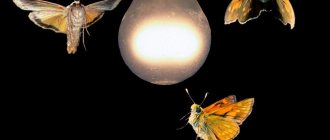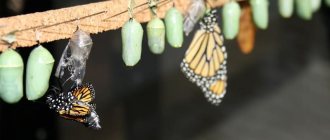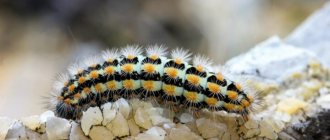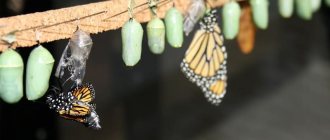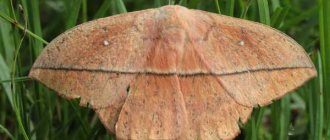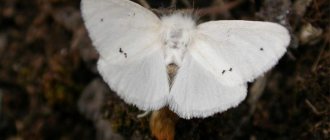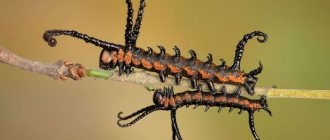Hello DIYers and gardeners, especially those who like to experiment with growing plants or pest control! Today I want to share one, in my opinion, very interesting and original way of combating one of the most serious pests of cabbage - white butterflies. More precisely, we are not talking about fighting, but about scaring away these pests. I recently learned about this method from the Internet.
In general, it must be said that white butterflies are one of the most malicious pests of cabbage, since they lay eggs on cabbage, from which greenish-yellow caterpillars then hatch. Immediately after hatching, these caterpillars begin to eat cabbage leaves at a very fast pace, so much so that they can completely destroy the entire cabbage harvest.
It is very difficult to fight them. Hand collection of these caterpillars often does not give reliable results, since the caterpillars penetrate deep into the leaves of the cabbage head. Poisoning them with chemicals is also undesirable, since we ourselves will then eat this cabbage.
You can, however, cover cabbage plantings with a fine-mesh plastic net so that butterflies cannot land on it and lay eggs at all. However, this method is bad in that due to the constant care of cabbage (weeding, weed removal, watering, fertilizing, etc.), such a net will need to be removed periodically. And recently, from the Internet, I learned about one very original way to combat white butterflies. The essence of this method is that thin, low pegs are installed on cabbage beds, onto which objects made of small white plastic are placed. We are talking about small plastic cups, drink caps, etc. Moreover, you can even use empty white egg shells.
So, it is believed that white butterflies, seeing white plastic objects, mistake them for their colleagues - butterflies and think that this place is already occupied. Therefore, they no longer try to lay eggs in this bed, but fly away to look for another - a free cabbage bed.
To be honest, this method does not inspire much confidence. However, it is worth recognizing that if this method really works, then it is perhaps the most original, simple and inexpensive way to combat white butterflies. Therefore, be that as it may, I decided to conduct an experiment and try this method on my site. Moreover, for greater efficiency, I will slightly refine this method in terms of making artificial plastic butterflies look as much like real ones as possible.
To imitate butterflies, I decided to use these plastic lids from cardboard milk cartons. Moreover, in size, they are just right.
Botanical description of the pest
The pest belongs to the white butterfly family. The external features of the small insect are as follows:
- Body structure: dark body, white wings with black spots. Size about 2–3 cm.
- The wingspan of females reaches 6 cm, while that of males is slightly smaller.
- Butterfly caterpillars are blue-greenish in color with three yellow stripes and black dots on the back.
- The 2.5 cm pupa is yellow-green in color and has gray-brown spots on it. It is entwined with a silky thread, with which it holds onto the leaf of the plant.
- The butterfly has well-developed visual organs, as well as a keen sense of smell. The front legs and club-like thickenings on the antennae serve as organs of touch.
Life cycle and reproduction of the cabbage butterfly
At the beginning of May, the cabbage butterfly becomes active and reproduces quickly. During a season, the insect can produce up to five generations, so getting rid of cabbage grass is not easy. The life cycle of the cabbage butterfly includes 4 metamorphotic states:
- Egg. The female's fertility is 250–300 eggs. The adult individual lays them on the underside of the leaves of the crop. Ripening period is from 5 to 12 days.
- The butterfly caterpillar size is up to 35 mm. The larva gradually feeds and molts frequently (about 4 times), and the interval may vary each time. This is due to the ambient temperature as well as seasonal humidity. The larval stage takes between two and five weeks. After birth, caterpillars penetrate cabbage leaves and make passages in them. Here they linger for several days (2-3), after which they crawl out to the surface of the leaf and begin to devour its untouched skin. Having finished feeding, they remain on the plant and begin weaving a cobweb cocoon. The pupation procedure takes place there.
- The butterfly pupa is an intermediate stage of development. She is the wintering phase of the cabbage whiteweed. The height of the cocoon, which has the shape of a barrel, is three centimeters. Its color is dirty green, with an admixture of yellowness dotted with dark patches.
- The small white adult is a definitive stage in which it does not grow or change. In this phase, the insect is capable of reproduction and settlement.
What protective measures will help to grow a good harvest of vegetables in the country?
Measures to protect cabbage must be taken long before it is transplanted into open ground. The site for planting cabbage is selected and prepared in the fall, for this:
- follow the rules of crop rotation (it is impossible to plant cabbage in the same place not only because of bacteria and fungal spores remaining in the soil, but also because of the pupae and adults of pests that overwinter in it);
- all remnants of the previous cabbage harvest are removed, as well as weeds of the cruciferous family - insects can also overwinter in them;
- They dig the area deeply so that the pupae of insect pests end up on the surface and die from low winter temperatures.
Causes and signs of white blight on cabbage
As soon as the butterfly begins to fly over the cabbage, this is a reason to inspect the plant and begin to fight the cabbage butterfly. There is no substantiated reason for this cabbage invasion. It has been noticed that the white butterfly is activated in hot and dry warm weather. Rainy weather has a detrimental effect on it.
This pest can be identified by the following signs:
- damage to cabbage leaves - they begin to turn yellow, dry out, lose their elasticity, and pinholes appear;
- the growth of the head of cabbage stops;
- caterpillars appear.
What harm does cabbage beds cause?
The appearance of an uninvited guest on a cabbage plantation is fraught not only with the fact that the insect spoils the plant, but it also begins to destroy the moisture produced by the vegetable. Because of this, the cabbage stops growing and then dies completely.
In addition, the caterpillars leave their waste products on the leaves, which provokes infection of the plant. Rot, fungal and viral diseases appear on the crop, which quickly spread to neighboring plantings.
In order to prevent this phenomenon and save cabbage from the invasion of cabbage butterflies, it is necessary to immediately spray the planting with insecticides or use available means of combating a similar effect after detecting the pest.
Dangerous cruciferous flea beetle
One of the most dangerous pests for young shoots of cabbage and other crops of this species is the cruciferous flea beetle. It is a small jumping beetle with a body length of about three millimeters.
After winter is over, this pest can be hidden in the surface layer of soil, fallen leaves, greenhouse and greenhouse crevices. The beetles wake up in early spring when the soil settles. First, adult insects eat cabbage weeds, and then begin to eat cabbage vegetables and freshly planted seedlings. They mainly damage young leaves of plants. The beetles gnaw small holes on the leaves, which leads to the leaves drying out and the plant dying.
Control of cabbage pests - cruciferous flea beetles - is especially important in hot spring weather, when there are too many of them. At this time, the pest is capable of destroying absolutely all seedlings of planted seedlings over large areas, since it can eat a volume three times its weight.
Ways to control insects
The choice of protection option directly depends on the timing of detection of the attack and damage. Sometimes, in order to save plantings, preventive spraying is quite enough. However, in most cases a different approach is required. To protect cabbage from butterfly attacks, you can use different control methods:
- chemical;
- biological;
- folk remedies.
Gardening stores offer a wide range of effective drugs that can successfully fight whiteweed. It can be:
- antibacterial and biological drugs;
- organophosphates;
- karbofos;
- microbiological insecticides.
These products are recommended for use at any stage of an insect attack.
Attention! It is possible to successfully process cabbage using folk remedies. Although these measures are effective only in the early stages of detecting an insect.
What to poison: chemicals and insecticides
The use of chemicals is a drastic way to solve the problem. It is used when nothing else helps - then you need to arm yourself with powerful insecticides.
There is only one, but very significant drawback. When chemicals are used, significant harm is caused not only to whites, but also to beneficial insects inhabiting the garden and birds.
Kinmiks
This is a pyrethroid insecticide that has a contact-intestinal effect on the whitefish. They need to spray cabbage plantings against butterflies when the plant is growing and many pests are found on it. The effect occurs after 3 weeks.
The concentration of the solution is not affected by the type of plant. Before use, you need to dilute an ampoule of the product in a bucket of water. The prepared mixture cannot be stored. Kinmiks does not accumulate on cabbage leaves at all; it completely decomposes a week after spraying.
Fitoverm
The drug contains waste products of microorganisms inhabiting the soil. It degrades quickly and is completely safe for the environment.
The product is sold in a liquid state. It should be diluted with water to obtain a solution that should be used to water the plants. For the event, choose a sunny day when no precipitation is expected.
Folk remedies
Gardeners have come up with many folk ways to protect cabbage plantings from whiteweed. Control using such methods is safe for other plants; it will not destroy microorganisms inhabiting the garden bed.
Effective folk remedies for killing caterpillars on cabbage
Experienced summer residents recommend taking preventive measures. In mid-April, you just need to wash off the cabbage pupae that are caught there from the surface of houses and fences with running water. To repel the pest, it is advisable to plant valerian, mint or marigold near the cabbage. Another acceptable option is to install baits. It is recommended to place small containers filled with a sweet solution of brewer’s yeast between the plants.
Vinegar solution
It is recommended to dilute a half-liter bottle of 9% vinegar with ten liters of drinking water. Instead of vinegar, you can use its essence by adding 2 tbsp. l. The resulting solution should be watered over the beds.
Sagebrush
It is recommended to plant wormwood around the bed where cabbage is planned to be planted. She will become a real savior of the vegetable, guaranteed to scare away the white.
Mustard infusion
Pour 2 tbsp into a bucket of water. l. mustard, similar amount of salt, 1 tsp. ground black pepper. Thoroughly spray the cabbage plantings with the resulting mixture.
Laundry soap and ash
Before using this method, you need to accumulate wood ash in advance. First you need to sift it so that the substance becomes very fine. In the evening, you first need to water the cabbage, carefully moistening its leaves. Then sprinkle the leaves with ash through a small strainer. Although the cabbage will turn out ugly after processing, this is not the main thing. But the ash is good at repelling any pests.
Interesting! Another recipe involves using, in addition to ash, laundry soap. In a bucket filled with boiling water, you need to infuse 0.5 kg of sifted wood ash. Strain the solution, and then add liquid soap (2 tbsp.) to it. All plants must be treated with the resulting liquid. It is better to carry out the procedure in dry, windless weather, then the solution will have time to be well absorbed. It is recommended to carry out this treatment in the evening.
Biological protection
The safest method of destroying cabbage caterpillars is to attract its natural enemies to the garden bed: insects and birds. If the garden exudes the smell of herbs, ladybugs and beetles will fly to it. They are guaranteed to destroy caterpillars and aphids, leaving the plants intact.
Attracting birds to your garden is an effective way to protect your cabbage from pests. Build birdhouses and feed the birds regularly. Wasps and ants are excellent hunters, feasting on caterpillars. These insects feed their larvae with them. To attract them to the beds, water the cabbage with honey or sugar solution.
Advice! It is recommended to use Bitoxibacillin, a biological agent that protects against whites. It contains exotoxin and bacterial spores. Take 100 g of the substance into a bucket of water and mix thoroughly. To increase the stickiness of the solution, it is advisable to add dry milk (a couple of tablespoons is enough). Apply the prepared suspension to the leaves when the weather is dry. After a week, repeat the treatment. The drug is completely non-toxic.
Adviсe
Removing cabbage from a cabbage bed is not that difficult. A few tips will help you do this several times faster:
- caterpillars or larvae can be removed by hand after wearing gloves;
- butterflies love sugar, so prepare bait: dissolve 2 tablespoons of sugar in a glass of water and place it next to the cabbage. When butterflies accumulate near the bait, they are caught and destroyed;
- Place ash paths near the cabbage beds. Wood ash is a faithful assistant in the fight against butterflies.
The fight against insects will be won if the treatment is carried out regularly and in the specified proportions. In the initial stages of infection, butterflies can be easily defeated in just a couple of days; in advanced cases, destruction can take weeks. Folk remedies always help, so there is no need for chemicals. The harvest will be saved and preserved, and pests will leave the area forever.
Preventative work
Experienced gardeners recommend the following preventive measures against whiteweed:
- regularly at the very beginning of the season it is necessary to destroy all weeds in the garden, since butterflies lay eggs on them in early spring;
- perform a daily inspection of the lower part of the leaves, scrupulously collecting all the laid white eggs;
- to reduce the pest population, it is advisable to dig up the garden in the fall;
- before winter you need to carefully check the bark of trees, find and destroy caterpillar pupae;
- It is advisable to plant cabbage seedlings early, while the butterflies are not yet flying en masse;
- You can’t plant cabbage next to mustard, horseradish, and radishes;
- when the bed is small, you can cover it with a plastic mesh that allows the sun's rays to pass through, but does not allow the leaves to come into contact with the butterflies.
Interesting life hacks
Popular thought is not asleep, and such research is supported by famous farmers of the country.
The famous garden designer and TV presenter Olga Platonova advises sticking sticks with washed egg shells on the tops next to the cabbage. Flying over these devices, the cabbage butterfly will think that another of its fellow tribesmen is laying eggs in this area, and will not touch the planting.
Reputable gardeners also advise covering slightly grown cabbage with low-density white non-woven material or a mesh with small cells. Then not only the whitefish, but also other pests will not be able to penetrate here. In the same way, you can save cabbage from other pests.
Some lay out boards between the rows of plantings, and when caterpillars crawl under them in the heat, they collect and destroy the pests.
Expert opinion Mityuk Stefania Bogdanovna Gardeners also plant next to plants that are annoyed by whites, onions, garlic, and marigolds. The smell of these crops will repel pests, and you will receive additional decorations in the form of flowers, and you will be able to compact the plantings by growing onions and garlic here.
